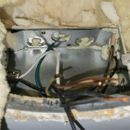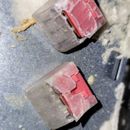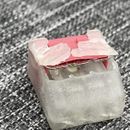Spray foam and plastic deterioration
This is not a project I was involved but is a project for a company which I am working with as a project manager. I thought this would be a great place to share and post this experience and learn if others have had this experience.
The following email (edited) is from the electrician about what he found 6 years after this project was complete.
Basically the connectors inside the box have deteriorated.
EMAIL:
Hi —————
One of the jobs I’m looking at is a repair I did at the ———’s house in the late fall. ————- and ———— called to say that most of the can lights in the playroom over the garage stopped working. I determined that the problem was a bad neutral connection in one of the fixtures, the one closest to the door. It took a while, but I was able to get the fixture out of the ceiling without damaging it and access the J-box on the side of the fixture (most of the can was immersed in foam insulation even though the insulation guys tried to surround the cans with fiberglass). The cause of the bad connection was that the factory installed connectors in the fixture had completely deteriorated; they looked like they had been in direct sunlight for 20 years. When the plastic disintegrated, the metal contacts in the connectors lost tension and the neutrals were no longer connected. I’ve never seen this before and can come up with only a couple of possible reasons. 1. The connectors were defective, or 2. Gases emitted by the foam that seeped into the J-box caused the plastic to deteriorate.
Has anyone experienced this and could it be a result if the spray foam off gas?
Thank you
Craig
GBA Detail Library
A collection of one thousand construction details organized by climate and house part












Replies
It’s hard to discern from the picture, but my assumption is an open cell foam encasing the housing? Is the housing IC rated? Is the space above conditioned? Climate zone? It could be a matter of condensation though there doesn’t appear to show signs of oxidizing. How thick is the foam above? I believe 1 1/4” closed cell serves a vapor barrier, not sure on open.
No knockouts used in the box :/
Consider LED disc lights. 3/4” depth with color rendering options, easy retrofit, inexpensive, allows option to insulate existing cavity and are rated for wet areas
Most IC rated fixtures I've seen actually say they are NOT rated to be in contact with SPRAY FOAM. You aren't supposed to encapsulate them in spray foam. They are rated to be in contact with things like fiberglass/mineral wool/cellulose, but not what I'd call "fluid applied" insulation like spray foam.
Solvents evaporating from curing plastics and cause problems like you see here. A classic example is stuff around newly applied silicone caulk, because silicone caulk cures by evaporation of acetone, and that acetone can damage some kinds of materials if they're nearby. I haven't seen spray foam cause degredation like this before though.
That plastic looks more likely to be damaged by heat to me. It's possible it was always loose, never making good contact, and ran hot as a result. Keep it hot over time, and the plastic will degrade and fail similar to what you're seeing in your pics.
Bill
Thank you for the response.
Were the connectors in contact with the foam? Spray foam can cause plastic failure in pipes, from the fire retardents and catalysts in the foam, and possibly the heat from curing. CPVC pipes under pressure are isolated / protected from spray foam applications for this reason (I think incidental foaming of small penetrations in floor plates/joists is tolerable).
I will have to ask the electrician if the foam came in contact with the connectors.
I have never been a fan of the push in connectors in general.
I don’t see a name brand on the connector. One has to wonder if the connector was UL approved when installed.
I did not see a name brand for the pot light and if it was UL listed.
About 1/3 of the way thru this article it shows a similar looking Wago brand “Wall Nut” connector and states it is not UL listed but the article could be out of date.
https://inspectapedia.com/electric/Electrical_Wiring_Splices.php
My guess no one will willingly take responsibility for the problem and the cost of proving one or the other is responsible will exceed cost of replacing the suspect connectors.
Seems to me the smart move is to pull all the can lights and replace any other similar connectors before they fail and possibly start a fire.
Walta
Thank you for the reply. I feel confident the electrician who performed the work and is one to question fixture application so having a UL listed fixture I would wager he checked. I need to ask more questions hence the reason for posting things I haven't considered. You have brought up questions that I need to ask and appreciate. I was told he specifically asked the foam crew to wrap the fixture in fiberglass insulation prior to foaming but I believe the foam expanded down under the fiberglass and into the j-box...how much into the J-box I am not sure and will get clarification.